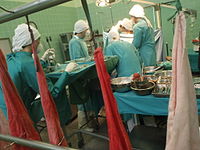
Photo from wikipedia
Background Treating Mycobacterium tuberculosis (TB) in solid organ transplant patients is challenging. Drug– drug interaction between tacrolimus and the cornerstone of TB treatment rifampin threaten the transplanted organ with rejection… Click to show full abstract
Background Treating Mycobacterium tuberculosis (TB) in solid organ transplant patients is challenging. Drug– drug interaction between tacrolimus and the cornerstone of TB treatment rifampin threaten the transplanted organ with rejection or tuberculosis with treatment failure. The interaction leads to decrease tacrolimus levels and may lead to increase the risk of rejection. The aim of the study is to assess the relationship between tacrolimus levels after the introduction of rifampin for the treatment of active TB in solid organ transplant (SOT) recipients. Methods Study was conducted in a large tertiary hospital with organ transplant center in Riyadh, Saudi Arabia. Medical records from 2004 till 2016 were reviewed. Patients were included if they were 14 years old or older, have had solid organ transplantation, active TB after transplant, ≥ 2 weeks of concurrent rifampin and tacrolimus, ≥ 2 tacrolimus level measurements before starting antituberculosis treatment (ATT), while on ATT, and after discontinuation of ATT. In this study, we considered levels of tacrolimus in three distinct time periods for each patient time period A: prior to the patient becoming infected with TB, time period B: after TB diagnosis and during rifampin administration, and time period C: after rifampin was discontinued. Any drugs that might affect tacrolimus and/or rifampin levels were recorded. The primary outcome is to assess changes of tacrolimus levels, dosing and the magnitude of change associated with rifampin introduction and after reaching steady state. Secondary outcomes were biopsy proven rejection and side effects associated with ATT.The study was approved by our IRB Results Total of 33 patients met the inclusion criteria. Twenty-two were male, mean age was 51 years (Table 1) Twenty-five of the 33 patients received rifampin-containing regimen and remaining eight received rifampin-sparing regimen, only patients who achieved target levels of tacrolimus were included in the analysis. In rifampin group, 23 patients were included in the analysis. The mean dose of tacrolimus from period A to B was increased by 164% to maintain the targeted level, and the mean dose of tacrolimus from period B to C was decreased by 40% to reach therapeutic levels of tacrolimus (Figure 1). Six patients had increase in ALT 4 of them had increase of ≥3 times the upper limit without gastrointestinal symptoms, the remaining 2 had ≥5 increase in ALT and ATT was held. Rejection was documented in 3 patients all of them received rifampin 2 had low levels at the time of the rejection but the doses of tacrolimus were increased till the therapeutic levels achieved, the other patient had therapeutic levels at the time of the rejection and rifampin was not stopped in all patients. Figure. No caption available. Figure. No caption available. Conclusion Our data showed that the drug- drug interaction between tacrolimus and rifampin was manageable by increasing the dose of tacrolimus to reach therapeutic levels.
Journal Title: Transplantation
Year Published: 2018
Link to full text (if available)
Share on Social Media: Sign Up to like & get
recommendations!